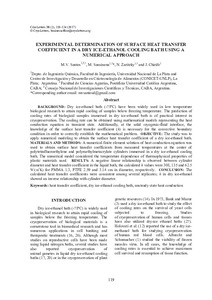Please use this identifier to cite or link to this item:
https://repositorio.uca.edu.ar/handle/123456789/15089| Título: | Experimental determination of surface heat transfer coefficient in a dry ice-ethanol cooling bath using a numerical approach | Autor: | Santos, María V. Sansiñena, Marina Julia Zaritzky, Noemí Chirife, Jorge |
Palabras clave: | TEMPERATURA; ENFRIAMIENTO; TRANSFERENCIA DE CALOR; ETANOL | Fecha de publicación: | 2017 | Cita: | Santos, M. V. et al. Experimental determination of surface heat transfer coefficient in a dry ice-ethanol cooling bath using a numerical approach [en línea]. Cryolettes. 2017, 38 (2). Disponible en: https://repositorio.uca.edu.ar/handle/123456789/15089 | Resumen: | Abstract: Background: Dry ice-ethanol bath (-78ºC) have been widely used in low temperature biological research to attain rapid cooling of samples below freezing temperature. The prediction of cooling rates of biological samples immersed in dry ice-ethanol bath is of practical interest in cryopreservation. The cooling rate can be obtained using mathematical models representing the heat conduction equation in transient state. Additionally, at the solid cryogenic-fluid interface, the knowledge of the surface heat transfer coefficient (h) is necessary for the convective boundary condition in order to correctly establish the mathematical problem. Objective: The study was to apply numerical modeling to obtain the surface heat transfer coefficient of a dry ice-ethanol bath. Materials and methods: A numerical finite element solution of heat conduction equation was used to obtain surface heat transfer coefficients from measured temperatures at the center of polytetrafluoroethylene and polymethylmetacrylate cylinders immersed in a dry ice-ethanol cooling bath. The numerical model considered the temperature dependence of thermophysical properties of plastic materials used. Results: A negative linear relationship is observed between cylinder diameter and heat transfer coefficient in the liquid bath, the calculated h values were 308, 135 and 62.5 W/(m2K) for PMMA 1.3, PTFE 2.59 and 3.14 cm in diameter, respectively. Conclusion: The calculated heat transfer coefficients were consistent among several replicates; h in dry ice-ethanol showed an inverse relationship with cylinder diameter. | URI: | https://repositorio.uca.edu.ar/handle/123456789/15089 | ISSN: | 0143-2044 | Disciplina: | INGENIERIA EN ALIMENTOS | Derechos: | Acceso abierto | Fuente: | Cryolettes. 2017, 38 (2) |
| Appears in Collections: | Artículos |
Files in This Item:
| File | Description | Size | Format | |
|---|---|---|---|---|
| experimental-determination-surface.pdf | 549,93 kB | Adobe PDF |  View/Open |
Page view(s)
37
checked on Apr 27, 2024
Download(s)
116
checked on Apr 27, 2024
Google ScholarTM
Check
This item is licensed under a Creative Commons License

